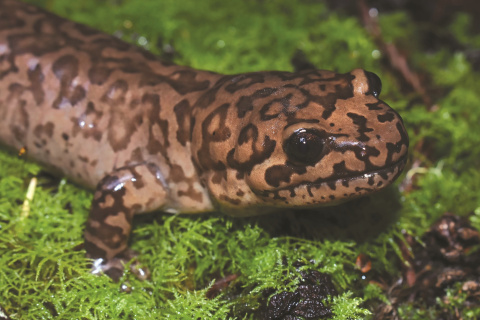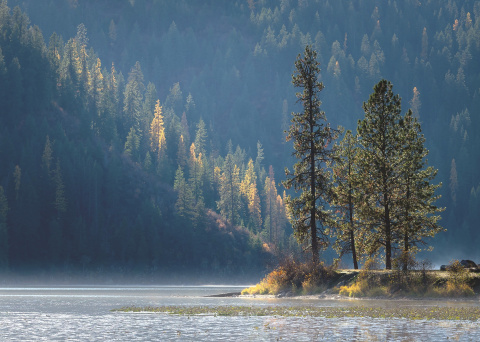Whether you moved to Idaho or were born and raised in the Gem State, it may surprise you to learn that there’s more to the state’s iconic image than just blue turf and potatoes. Idaho is a diverse outdoors state, characterized by several historic, economic and natural symbols from the mountain bluebird to the Western white pine. But what about the less commonly known symbols, like the Gem State’s state gem? Or state fruit? Can you name the state fossil?
Take a dive into this month’s Wildlife Express newsletter to learn more about what symbols define Idaho.

State Amphibian: Idaho Giant Salamander
Found only in the Gem State, Idaho giant salamanders (as the name implies) are large, vocal amphibians that call the mountain streams of Central and Northern Idaho home. Adults can grow up to a foot long and are dark brown or gray in color.
State Bird: Mountain Bluebird
One of the most vibrant critters seen during spring green-up season, a species of thrush called the mountain bluebird became the state bird of Idaho in 1931. Unlike other thrushes, mountain bluebirds will hover in the air before dropping down to catch their prey, which can be worms, snails, slugs, adult insects and fruit.
State Fruit: Huckleberry
Speaking of fruit, the most sought-after mountain morsel and Idaho state fruit is the huckleberry. Huckleberry bushes are slow growers and take a while to fruit, further adding to the mythos of the wild mountain fruit. In order to survive during the winter, huckleberry bushes depend on a covering layer of snow or else will freeze and die. Every summer, thousands of folks flock to the mountains in search of these tiny purple berries.

State Tree: Western White Pine
For berry pickers up north, you might encounter Idaho’s state tree this summer. Northern Idaho has more Western white pines than any other state. Western white pines can grow to be 175 feet tall, with the largest in the world (a whopping 219 feet tall) near Elk River.
State Fish: Cutthroat Trout
Many anglers around the state know the thrill of having a cutthroat trout on the end of their line. A native to Idaho, cutthroat trout can be found (and caught) in a wide range of environments, from small alpine streams to lowland reservoirs. Fun fact: A cutthroat’s scientific name (Oncorhynchus clarkii) comes from a well-known fella with the same name – William Clark of the Lewis and Clark expedition – who first observed and documented the fish’s iconic red slash mark along the throat.
State Insect: Monarch Butterfly
You may recall March 2022’s issue depicting Idaho’s most rugged migrants, and notably among that list is the state insect: the monarch butterfly. Monarchs can’t tolerate Idaho winters too well, and therefore head south, sometimes 2,000-3,000 miles away. The milkweed plant plays a valuable role in a monarch’s life, serving as both a main food source and a nursery for the butterfly’s eggs.
State Raptor: Peregrine Falcon
Peregrine falcons can clock out at 242 miles per hour when diving for prey, and their sleek bodies have inspired many modern, human-made technological designs. Imagine sticking your head out of a car going 242 miles per hour – breathing might be a little difficult. Falcons, however, are equipped with a small bony pegs called a tubercle which scientists believe can change how air flows over the bird’s nostril when flying.
Other State Emblems
For those interested in learning more about Idaho’s state symbols, be sure to check out the June edition of Wildlife Express, Idaho Fish and Game’s monthly educational wildlife newsletter. Wildlife Express is a great resource for teachers as well as parents and their kids who want to get their hands dirty with some fun DIY wildlife-inspired activities.

